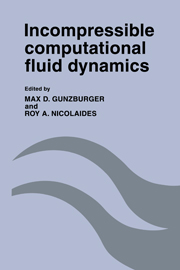Book contents
- Frontmatter
- Contents
- Preface
- Contributing Authors
- 1 A Few Tools For Turbulence Models In Navier-Stokes Equations
- 2 On Some Finite Element Methods for the Numerical Simulation of Incompressible Viscous Flow
- 3 CFD - An Industrial Perspective
- 4 Stabilized Finite Element Methods
- 5 Optimal Control and Optimization of Viscous, Incompressible Flows
- 6 A Fully-Coupled Finite Element Algorithm, Using Direct and Iterative Solvers, for the Incompressible Navier-Stokes Equations
- 7 Numerical Solution of the Incompressible Navier-Stokes Equations in Primitive Variables on Unstaggered Grids
- 8 Spectral Element and Lattice Gas Methods for Incompressible Fluid Dynamics
- 9 Design of Incompressible Flow Solvers: Practical Aspects
- 10 The Covolume Approach to Computing Incompressible Flows
- 11 Vortex Methods: An Introduction and Survey of Selected Research Topics
- 12 New Emerging Methods in Numerical Analysis: Applications to Fluid Mechanics
- 13 The Finite Element Method for Three Dimensional Incompressible Flow
- 14 A Posteriori Error Estimators and Adaptive Mesh-Refinement Techniques for the Navier-Stokes Equations
- Index
14 - A Posteriori Error Estimators and Adaptive Mesh-Refinement Techniques for the Navier-Stokes Equations
Published online by Cambridge University Press: 12 January 2010
- Frontmatter
- Contents
- Preface
- Contributing Authors
- 1 A Few Tools For Turbulence Models In Navier-Stokes Equations
- 2 On Some Finite Element Methods for the Numerical Simulation of Incompressible Viscous Flow
- 3 CFD - An Industrial Perspective
- 4 Stabilized Finite Element Methods
- 5 Optimal Control and Optimization of Viscous, Incompressible Flows
- 6 A Fully-Coupled Finite Element Algorithm, Using Direct and Iterative Solvers, for the Incompressible Navier-Stokes Equations
- 7 Numerical Solution of the Incompressible Navier-Stokes Equations in Primitive Variables on Unstaggered Grids
- 8 Spectral Element and Lattice Gas Methods for Incompressible Fluid Dynamics
- 9 Design of Incompressible Flow Solvers: Practical Aspects
- 10 The Covolume Approach to Computing Incompressible Flows
- 11 Vortex Methods: An Introduction and Survey of Selected Research Topics
- 12 New Emerging Methods in Numerical Analysis: Applications to Fluid Mechanics
- 13 The Finite Element Method for Three Dimensional Incompressible Flow
- 14 A Posteriori Error Estimators and Adaptive Mesh-Refinement Techniques for the Navier-Stokes Equations
- Index
Summary
The Adaptive Mesh-Refinement Philosophy
In computational fluid dynamics, as well as in other problems of physics or engineering, one often encounters the difficulty that the overall accuracy of the numerical solution is deteriorated by local singularities such as, e.g., singularities near re-entrant corners, interior or boundary layers, or shocks. An obvious remedy is to refine the discretization near the critical regions, i.e., to place more grid-points where the solution is less regular. The question then is how to identify these regions automatically and how to guarantee a good balance of the number of grid-points in the refined and un-refined regions such that the overall accuracy is optimal.
Another, closely related problem is to obtain reliable estimates of the accuracy of the computed numerical solution. A priori error estimates, as provided, e.g., by the standard error analysis for finite element or finite difference methods, are in general not sufficient, since they only yield asymptotic estimates and since the constants appearing in the estimates are usually not known explicitly. Morover, they often require regularity assumptions about the solution which, for practical problems, are hardly satisfied.
Therefore, a computational fluid dynamics code should be able to give reliable estimates of the local and global error of the computed numerical solution and to monitor an automatic, self-adaptive mesh-refinement based on these error estimates.
- Type
- Chapter
- Information
- Incompressible Computational Fluid DynamicsTrends and Advances, pp. 447 - 476Publisher: Cambridge University PressPrint publication year: 1993
- 18
- Cited by

